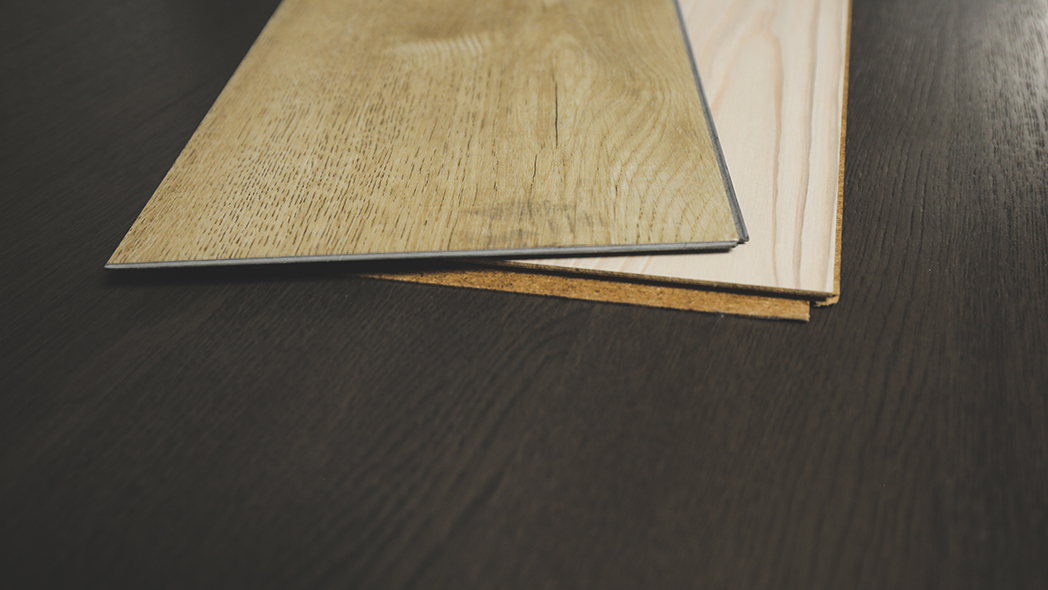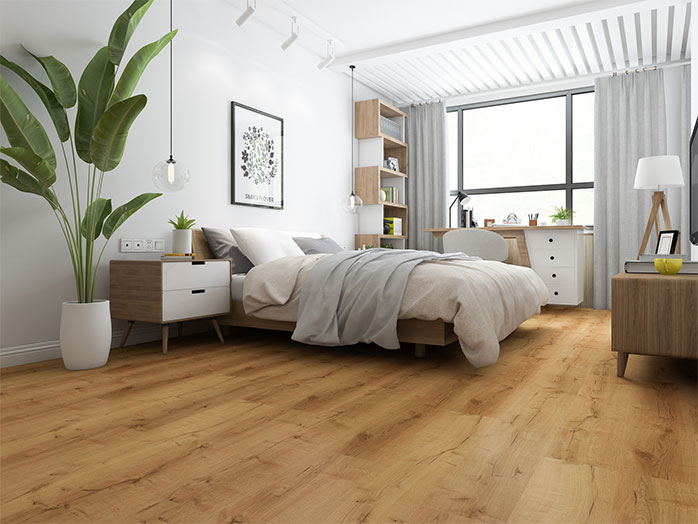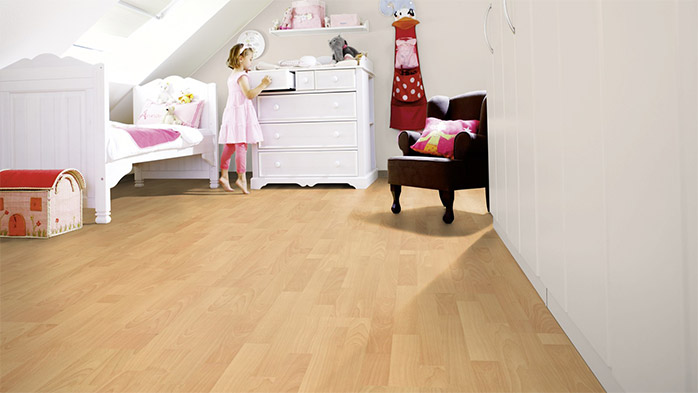
In this article, you will discover which is more suitable for your needs - vinyl flooring or laminate? There is much to say about these two very popular flooring options, but we aim to keep this article concise and to the point.
Both vinyl flooring and laminate have their strengths and weaknesses; therefore, it's essential to determine which flooring type best meets your requirements.
Content
- 1 What is Vinyl Flooring Made of?
- 2 What is Laminate Made of?
- 3 Vinyl Flooring and Laminate Compared: What are the Pros and Cons?
- 4 Installation Methods for Vinyl Flooring and Laminate
- 5 Conclusion: Vinyl Flooring vs. Laminate - Which is Better?
- 6 Experience the best service with planeo - because you need it!
What is Vinyl Flooring Made of?
Vinyl flooring is primarily made from polyvinyl chloride (PVC), with "vinyl" being a shorthand for polyVINYL chloride, a type of PVC. PVC is a thermoplastic material. Naturally, this isn't the only component of vinyl flooring, as additional elements like fillers, stabilisers, and plasticisers provide it with its distinct and advantageous properties: it is very durable, elastic, and pleasantly warm.
The top layer of vinyl flooring is known as the wear layer, which can vary in thickness. The thicker this layer, the longer it will take to wear down. Common thicknesses are 0.3 / 0.5 / 0.55 mm. A 0.3 mm wear layer is sufficient for residential use. In commercial settings or areas with heavier foot traffic, choose a thickness of 0.5 mm or more.
Not long ago, the plasticisers used in vinyl floors were considered harmful to health. This was indeed true! Manufacturers have responded accordingly: modern vinyl floors are safe for living spaces and only contain harmless plasticisers.
Caution is advised with cheap imports, as they might contain harmful plasticisers. Always check with your retailer beforehand! Our vinyl floors exclusively use safe plasticisers.
Nowadays, there are also vinyl floors or design floors (another name for these flexible floor coverings) that are entirely free of PVC and plasticisers.
What is Laminate Made of?
Laminate is not made from solid wood, as often believed, but from a high-density fibreboard (HDF). The HDF board serves as the core material and the main component of laminate, contributing to its robustness.
Laminate is a well-engineered construction consisting of several layers, with the HDF board being just one of them.
Although laminate, like vinyl flooring, has a wear layer (the topmost layer), in practice, the usage class (AC rating) is the crucial factor. This means that a thicker wear layer corresponds to a higher and more durable usage class. Both vinyl flooring and laminate share the same usage classes (AC ratings). The following table will help you easily determine the appropriate usage class for your needs:
| Usage Class | Residential Area | Usage Class | Commercial Area | Usage Class | Industrial Area |
|---|---|---|---|---|---|
| 21 | Bedroom, Guestroom | 31 | Small Offices, Hotel Rooms | 41 | Areas with predominantly seated activities (workshops) |
| 22 | Living Room, Dining Room, Children's Room | 32 | Small Shops, Doctor's Offices | 42 | Areas with predominantly standing activities (storage rooms) |
| 23 | Entrance Area, Hallway, Kitchen | 33 | Department Stores, Reception Areas, Open-Plan Offices | 43 | Warehouses and Production Halls |
Vinyl Flooring and Laminate Compared: What are the Pros and Cons?
Refer to our following list of pros and cons of both types of flooring. This will help you make an objective decision on which flooring is better suited for you – the trendy vinyl flooring or the tried-and-true laminate?
What are the Advantages of Vinyl Flooring?
Vinyl flooring comes in a nearly limitless range of beautiful designs. From incredibly realistic wood effects to authentic stone looks and bold tile patterns, there's something for everyone. In terms of designs and choices, vinyl flooring already offers more than laminate.
Due to its many variations, there's a solution for every need! As solid vinyl (also known as luxury vinyl tile or LVT), it is completely waterproof and can even be installed in showers. For laminate, however, water is its biggest enemy and a significant disadvantage.
Vinyl Flooring Bathroom Shower - Easy Installation
When renovating, you might often find restrictions in floor height due to local conditions (e.g., doors, frames, thresholds). Here, vinyl flooring plays one of its biggest advantages: self-adhesive vinyl flooring is available with a thickness of only 2 mm.
Vinyl flooring belongs to the category of resilient flooring, which positively impacts the joints. It is also quiet and warm underfoot. These features cannot be matched by laminate due to its structure.
Thanks to its tough, elastic surface, vinyl flooring is more wear-resistant than most other types of flooring and is as robust as laminate.
Another advantage of vinyl flooring is its easy-to-maintain surface, regardless of whether it's textured or not. This surface also makes vinyl flooring stain-resistant. Some vinyl floors have anti-static properties, preventing dust and dirt from sticking to the floor.

Disadvantages of Vinyl Flooring
Where there are many advantages, there can't be as many disadvantages – and that's the case with vinyl flooring. Its drawbacks include the fact that it can be difficult to remove if glued down. This only applies to the glued version and only if no underlay or adhesive film was used. However, if you still want to install particularly thin vinyl flooring, the subfloor must be extremely well prepared.
As mentioned earlier, there are still cheap import products available that contain harmful plasticisers. You should definitely check with your retailer before purchasing!
What are the Advantages of Laminate?
Laminate also comes in a wide variety of designs, ensuring there is something for every customer.
Laminate is never glued; instead, it is easily clicked together piece by piece. This leads to its second advantage: laminate can be easily dismantled without damaging the subfloor. However, this advantage also applies to vinyl flooring if you choose the click version. Click vinyl is not glued but clicked together just like laminate. Since it does not form a permanent adhesive bond with the subfloor, it is known as "floating" installation.
If you want a particularly robust floor, laminate is the right choice. Its hardness can withstand various point loads. Unfortunately, this advantage also comes with a disadvantage: due to its structure, laminate has a higher noise level, promoting both impact and room noise.
Other advantages of laminate include its price, as laminate is generally cheaper than vinyl flooring. This is due to its less expensive raw materials and somewhat less complex manufacturing process.
Laminate is as easy to clean as vinyl flooring. However, water should not sit on laminate for too long, as it can eventually cause swelling. Laminate is stain-resistant and easy to maintain. It can be swept, vacuumed, and mopped.

Disadvantages of Laminate
One of the major disadvantages of laminate is its sensitivity to moisture. Thus, laminate is not suitable for wet areas. For example, you cannot renovate a bathroom with it.
Additionally, you should never lay laminate without underlay, as every step will otherwise be transmitted unfiltered to adjacent and lower rooms.
Laminate cannot be sanded down, as it is not solid wood like parquet. If you do sand it, you will destroy the wear layer (decorative layer) and thus your entire laminate flooring.
Moreover, laminate is generally considered cold and cannot store heat. People sensitive to cold should therefore prepare themselves with thick socks or slippers from the start.
It is widely believed that laminate is very environmentally friendly. However, that's not the whole truth. The production of laminate involves more energy consumption and air pollutant emissions than parquet. Additionally, the resins used in manufacturing can contain harmful formaldehyde – check with your retailer about this!
Installation Methods for Vinyl Flooring and Laminate
Here, we will briefly outline the installation methods available for vinyl flooring and laminate. We have created the following summary table for you. It's best to leave the installation of vinyl flooring with "wet bed adhesive" to a professional. It is crucial that the subfloor is perfectly prepared; otherwise, even small irregularities can transfer to the new floor and become visible.
All other installation methods are straightforward and can be done with a bit of courage. Vinyl floors and laminate are easiest to install using the practical click system.
Vinyl Flooring
| Installation Method | Brief Info |
|---|---|
| Install on Wet Bed Adhesive | Wet bed adhesive is applied to the levelled subfloor with a notched trowel. A solid bond forms between the vinyl flooring and the subfloor. |
| Install on Adhesive Underlay | The adhesive bond only forms between the vinyl flooring and the adhesive underlay. No solid bond forms between the adhesive underlay and the subfloor; this is known as "floating" installation. Particularly popular for adhesive vinyl installation. |
| Self-Adhesive Installation | Adhesive is pre-applied to the backside of the vinyl flooring. It is installed on a bare subfloor, forming a solid bond between the vinyl flooring and the subfloor. |
| Install on Double-Sided Adhesive Film | Double-sided adhesive film is first applied to the levelled subfloor, then the vinyl flooring is applied to the film. Both the vinyl flooring and the adhesive film are removable. |
| Install on Underlay | Pure "floating" installation. No adhesive bond with underlay or subfloor. Particularly popular for click vinyl installation. |
Laminate
| Installation Method | Brief Info |
| Install on Underlay | Most laminate is installed "floating" on underlay. No adhesive bonds are used. The click system has virtually replaced all other connection types (e.g., tongue and groove) in the market. |
Conclusion: Vinyl Flooring vs. Laminate - Which is Better?
The trend is clearly leaning towards vinyl flooring. This is evident from its vast array of beautiful designs and various installation options. Vinyl flooring manufacturers have developed solutions for nearly every requirement. Laminate, on the other hand, has been on the market since 1977 and is likely to be gradually replaced by vinyl flooring.
Which flooring is better for you personally depends on your taste and especially on your requirements. That is for you to decide!
If you have a limited budget and live in a rented apartment, it makes sense to look at laminate. You can install it yourself and remove it completely when you move out. For wet rooms, however, you should look for other solutions, as laminate is not suitable for those. In contrast, laminate is more resistant to scratches due to its hardness. However, neither type of flooring is 100% scratch-resistant.
Vinyl flooring is a bit more expensive but offers more comfort. It is warm underfoot, easy on the joints, and quiet. As solid vinyl, you can install it throughout your entire house, including the kitchen, bathroom, and shower area. This allows you to have a uniform floor throughout the house. Thanks to the click system, vinyl flooring is also easy to install and later remove completely. Vinyl flooring is something like the universal floor covering.
You can quickly renovate with both types of flooring. With vinyl flooring, renovation is even dust-free and quiet because no saw is needed.
For a better and easier comparison, we list all the advantages and disadvantages of both floor types clearly:
| ADVANTAGES - Vinyl Flooring | ADVANTAGES - Laminate |
|---|---|
| Pleasantly warm underfoot | Wide range of designs, large selection of wood, stone, and tile decors |
| Highly durable, very abrasion-resistant | Many different formats |
| As solid vinyl, waterproof, suitable for bathrooms and kitchens | Easy installation thanks to click system |
| Quiet, less noise than other hard floorings | Easily dismantled without damaging the subfloor |
| Easy to maintain, can be vacuumed and mopped | Can be installed over underfloor heating |
| Many and easy installation options, can be glued or clicked | Highly durable, very abrasion-resistant |
| Can be installed over underfloor heating | Less prone to scratches due to hard surface |
| Height from 2 mm, good problem solver for renovations | Cheaper than other hard floorings |
| Ideal for dust-free and quiet renovation | Easy to clean |
| Wide range of designs, large selection of wood, stone, and tile decors | Height from 6 mm, good for renovations |
| Many different formats | |
| Elastic, gentle on joints | |
| Must meet emission and pollutant guidelines from authorities and testing institutes, hence safe for health | |
| Recyclable, can be fully reprocessed |
| DISADVANTAGES - Vinyl Flooring | DISADVANTAGES - Laminate |
| Fully glued version is difficult to remove | Sensitive to water, not suitable for wet rooms |
| Subfloor must be particularly well prepared | Always requires impact sound insulation |
| Cheap import products may contain harmful plasticisers | Cannot be sanded down like parquet |
| Not a natural product | Cold underfoot, cannot store heat |
| Soft surface, therefore susceptible to scratches | Not a natural product |
| Not compatible with high heat, unsuitable for saunas or near fireplaces | Loud, high impact sound and room noise |
| Final disposal only possible in incineration plants | Not necessarily environmentally friendly, production involves increased energy consumption and air pollutant emissions |
| Cheap products may contain harmful formaldehyde in the resin |
Experience the best service with planeo - because you need it!
No matter what challenges you face with your project, planeo provides you with the right solution. Benefit from the advantages of our services:
- Free samples⁴ for many of our products: Order up to 7 samples at no cost, for instance, of our vinyl floors or laminate floors.
- Express delivery² - for urgent projects and quick decisions.
- Expert advice¹ - We offer professional consultation through our contact page or answer your questions directly in the comments.
These topics might also interest you
Vinyl Flooring or Tiles - Which Flooring is Better?